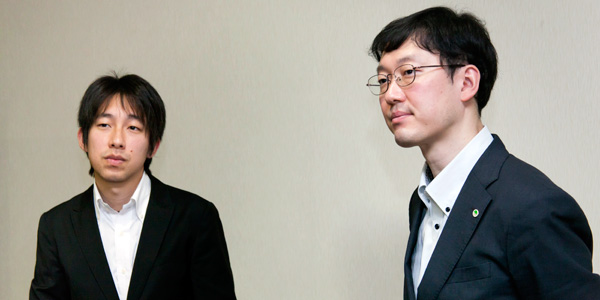Imagine passing through the ticket gate at a train station with a mere wave of the hand–the finger vein authentication technology currently being researched could make this kind of convenient social infrastructure a reality.
In light of the growing demand for safety and security in society, Hitachi, Ltd. has developed walkthrough-style finger vein authentication technology that avoids congestion even when there are large numbers of people.
Biometric identification technologies enable personal identification without stopping the flow of people and will make everyday life more secure, safe and convenient.
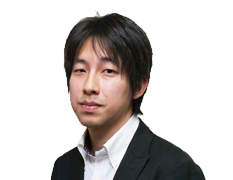
MATSUDA Yusuke
Researcher
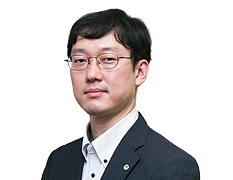
MIURA Naoto
Senior Researcher
(Publication: July 4, 2017)
MATSUDAYes, we've developed technology that can authenticate finger veins even while people walk. Hitachi has long focused on developing high-precision finger vein authentication. While this type of technology has been used for personal identification at ATMs, access control systems and logging into computers, these applications require fingers to be properly placed on a fixed location. The advantage of our walkthrough finger vein authentication is that it is both precise and usable while walking with a simple hand motion.
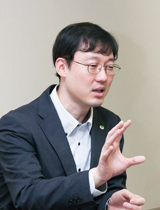
MIURAWe were very excited in 2013 when Tokyo was selected as the host city for the 2020 Olympic Games. On the other hand, this raised the social demand for safety and security more than ever before due to the concern of being a target of terrorism. In light of this, we discussed how to use the technology that we had at our research institute and came up with the idea of a "super secure city." Since then, we have conducted research aimed at realizing a society that is secure, safe and convenient.
The strength of our finger vein authentication technology was its precision. Such authentication, however, required people to stop and place their finger on a fixed location on the device, and the time that this takes was an issue.
If we could shorten the time this took, we could implement the technology at large-scale events, airports, train stations and other places and avoid congestion even during mass use. All we needed to do to cut down on time was make it so that people did not have to stop. This is how the development of walkthrough finger vein authentication via simple hand scanning began.
MIURABecause a walkthrough device was unprecedented and we had not conducted a single experiment, at the stage that we decided we were going to develop it, we were not sure that it would be possible. We carried out repeated experiments with various prototypes, discussed how we could clearly capture finger veins and how we could authenticate at a high level of precision.
MATSUDAWhen we decided to develop it, we also decided to introduce the idea at the exhibition of our research institute that was scheduled about half a year later. Even though people around us asked, "Are you really going to be able to do this in half a year?" and had to discuss many things such as what shape it should take, how big it should be, and what kind of cameras we should select, we could not afford to let the chance to showcase this new technology slip away.
MIURAAlthough we definitely did not have anything concrete, we had a lot of experience making several different finger vein authentication apparatuses, and had a general idea that "it might go well if we do this," to a certain degree.
However, there were many things that we could not predict, and we learned what kind of issues occur when you try to scan your hand while walking along. Because we only had a short period of six months to develop the project, we decided to make the hardware first, deduce specific issues from there, and solve them one by one.
MATSUDANormal finger vein recognition apparatuses have near-infrared LED above where you would place your finger, and a near-infrared camera installed below. When you place your finger on the fixed location, your finger is exposed to near-infrared rays from above, and the camera below takes a picture of the rays that permeate through your finger.
Figure 1 External appearance of walkthrough-style finger vein authentication apparatus

At first, we wanted to use that same mechanism, which means that near-infrared rays would permeate through the hand that was passing through, so we made an authentication device that was shaped like a sideways "U." However, we found that it was unexpectedly difficult to make your hand pass through a sideways "U," and our hands would often hit the top of the apparatus. This is where we made the drastic decision to make it "L" shaped, which is much more open.
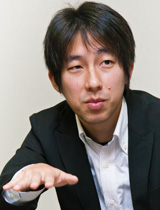
Moreover, when you scan your hand while walking, the position and the angles of your fingers necessarily change. In order to respond to this change, we decided to introduce an "array light source" which has multiple LEDs, making it possible to expose the fingers to near-infrared rays no matter where the fingers were.
One thing we were particularly creative about was how to detect the position of the hand and expose the fingers to near-infrared rays. By making the apparatus "L" shaped, not only did the finger positions and angles vary, but the height the hands would be scanned at also varied more than before. This is the point at which we installed a 3D range-imaging sensor together with the near-infrared camera at the bottom of the apparatus. This sensor can immediately detect the position of fingers, giving us the ability to control the array light source. By deciding which LED near-infrared rays to expose on the fingers, we were able to clearly capture the veins even with an "L" shaped apparatus.
MATSUDAThe first step of finger vein authentication is to cut out the portion of the fingers from the finger vein image captured by the near-infrared camera. Then the finger's veins are extracted, and finally the finger vein pattern is compared to the person's finger vein pattern that is registered in the database. This is the flow of how finger vein authentication works. Most finger vein authentication apparatuses utilize the vein patterns of one finger to authenticate, but with the walkthrough-style finger vein authentication apparatus, we identify people based on the combination of the vein patterns of multiple fingers.
Figure 2 Overview of the structure and authentication of the walkthrough-style finger vein authentication apparatus

Because we opened up the design of the apparatus, it is affected by near-infrared LED lights and ambient light, slightly decreasing the quality of the vein images for each finger. However, by utilizing the vein images of multiple fingers, we have succeeded in heightening the precision of authentication.
MIURAScanning your hand while walking is more of a natural movement compared to placing your finger on a fixed location. When the user scans their hand over the apparatus, the veins of multiple fingers can be captured at once. Furthermore, by utilizing the vein images of multiple fingers, the occurrence of errors decreased drastically compared to authentication using the vein images of one finger. We deemed this advantageous and decided to "use all of the finger images that we are able to capture."
MATSUDAYes, the development of the apparatus was handled by the division that specializes in hardware prototyping at our research laboratory. From an early stage we had briefing sessions where we would exchange opinions on what shapes the apparatus could be, and what shapes were best suited for the apparatus. The prototype was ready just in time.
On the other hand, because we could not make the deadline of the exhibition date in half a year if we had controlled the array light source and made the authentication processor after the prototype had arrived, we made a mockup of the apparatus out of Styrofoam and installed an LED, repeating tests over and over again.
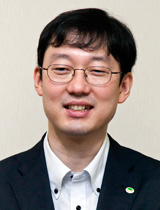
MIURAIn our experiments, we set a goal of under 0.5 seconds from the capturing of the finger veins to the authentication. By making improvements to the process of extracting finger vein patterns and the process of comparing the registered patterns, we were able to authenticate in 0.3 seconds, well below our initial goal.
Together with the improvements on the authentication process, we also considered the shape of the entire apparatus. For example, we walked and measured the distance from the finger scanning area to the doors of the gate and determining the distance needed between the two in order to walk through without bumping into the door, and utilized this data as a base for prototyping.
MIURAWe received a technological award within the company as our efforts to develop the apparatus within half a year and present it at the exhibition were highly evaluated. After the news release, we received several demonstration requests from outside of the company and we were busy responding to these.
MATSUDAOn the day of our news release, we were also interviewed by a TV station, and our technology was covered in a various ways. While all this was going on, people from a different team conducting research on a theme related to security asked, "You guys really did it in half a year?" with a sense of surprise, and I was very happy and had a sense of fulfillment.
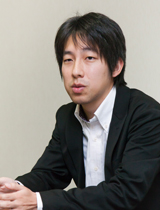
MATSUDABecause we were able to capture clear images of finger veins while people walk, we will now aim for the acceleration of the portion that cuts out the finger areas and extracts the finger vein patterns, as well as the portion where it authenticates by comparing it to registered finger vein patterns.
The walkthrough-style finger vein authentication apparatus was developed as a gate for where numerous people gather, but it is still in the trial stage and has not yet been used for thousands of people let alone for tens of thousands of people at once. After the acceleration of the extraction of patterns and comparison processes, I believe tests are needed to verify whether or not it can be used in an environment where many people gather.
MIURAIn the future, this is a technology that can be used at any gate where authentication takes place. I imagine that it would be convenient if you could use public transportation such as trains and busses without having to carry a ticket or a wallet. For this to happen, we must resolve a couple of tasks such as the miniaturization and cost reduction of the apparatus.
I also think that this technology is not limited to just walkthrough, but that you could use it in places such as convenience stores by operating a touch panel, and scanning your finger to make a payment. I am also thinking about applying it to smartphones. If you use the new technology we developed, you could extract vein patterns from images of fingers captured by a smartphone camera. If you could use this as a means of personal identification, you could register an image of your finger taken by your smartphone, and could enter event venues such as concerts, simply by scanning your finger over the smartphone camera incorporated in the gate. As you can see, its potential uses keep spreading.
MIURAMy goal and dream is to see the technology that I just mentioned above become a reality. Since we joined the company, both of us have always been interacting with finger vein authentication technology. Because we have specialized in research and development in this field, I hope to continue to do so and pursue technologies necessary for a secure and safe society.
Furthermore, through trial and error, I would like to develop a biometric identification technology which has a higher precision in authenticating and is more convenient than finger veins.
MATSUDABecause the use of products with finger vein authentication are limited to bank ATMs and logging into computers, I would like to develop it in to a technology with which people have many opportunities to interact on a daily basis. In order to do this, I think that we must make it more convenient, and raise the authentication precision.
I would like to establish biometric identification technologies that are fundamental technologies incorporated into infrastructure that everyone uses.
